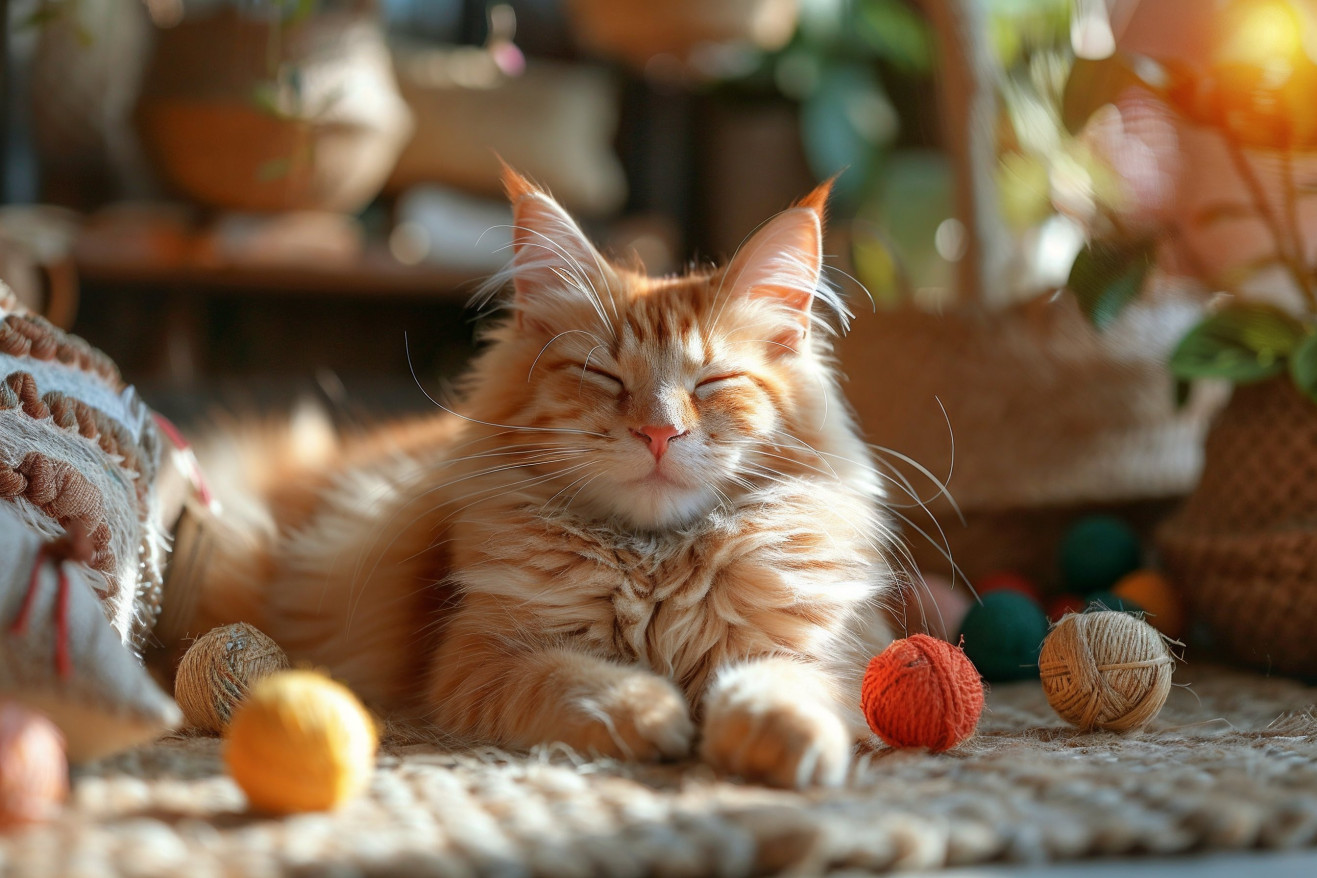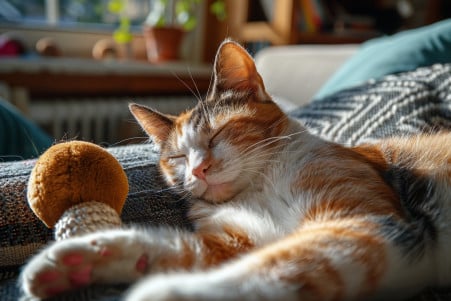What Do Cats Like? Exploring Feline Preferences and Behaviors
2 March 2024 • Updated 1 March 2024

As self-proclaimed kings and queens of comfort, cats have a way of leaving us scratching our heads when it comes to what they actually like. In general, cats like to sleep, groom, climb, play with toys, and birdwatch. They also like fresh food, water, a place to scratch, and positive human interaction. Meeting their needs for comfort and play will help satisfy their natural instincts.
To help you better understand your cat’s likes and dislikes, we’ll explore a variety of topics, including research in the fields of behavior and veterinary science, as well as information from animal behaviorists and the latest studies in feline psychology.
Through these different perspectives, you’ll gain a better understanding of how to create an environment that will help your cat live its best life. Our goal is to provide you with a well-rounded view that will help you improve your relationship with your beloved pet.
What do cats like in terms of comfort, stimulation, nutrition, and environmental enrichment?
How Cat Happiness Is Shown Through Behavior
Cats show their happiness through a range of behaviors that reflect their complex emotional lives. For instance, cats knead as a sign of relaxation and contentment, which is a throwback to their kitten days when they kneaded their mother’s stomach to stimulate milk production.
Purring is another classic sign of a happy cat, although it’s important to note that cats also purr when they’re in pain or distress, so the situation needs to be taken into account. Meanwhile, slow blinking, often called a “cat kiss,” is a sign of trust and love.
Other behaviors like scratching and the zoomies (sudden bursts of energy) are often misinterpreted. Both are natural and important for keeping a cat’s claws healthy and keeping them mentally stimulated, not destructive or hyperactive. An article by MedVet notes that it’s important for cat owners to provide their pets with scratching posts that meet their needs.
Cats also show their love and comfort through bunting and rubbing against their humans, which are signs of trust and territorial marking through scent, and choosing to sleep near their humans, which is a strong sign of a cat’s comfort and love.
It’s important for cat owners to recognize and respond to these behaviors since they help strengthen the bond between cats and their humans. Misunderstanding these behaviors can lead to a lack of connection, so it’s important to be observant and understand the nuances of a cat’s behavior. In doing so, cat owners can not only meet their cats’ needs but also develop a stronger, more fulfilling relationship with their pets.
Cat Food Preferences: Why Cats Have Them
When it comes to cat nutrition, protein is a top priority. Cats are obligate carnivores, which means they need a diet high in protein that includes essential amino acids that are only found in animal tissue. VCA Animal Hospitals explains that cats need these proteins and amino acids, like taurine and arginine, to help with basic bodily functions and overall health.
In addition, feeding cats several small meals a day, which is more in line with their natural eating habits, is in line with their natural feeding preferences.
Water is also an important part of a cat’s diet. Even though cats come from desert ancestors, which means they are good at conserving water, they still need to have access to fresh, clean water at all times. Many cats prefer to drink from running water sources, and water fountains can help them drink more water and stay better hydrated.
The texture and taste of food are important to cats, and they will develop preferences based on these factors. ASPCA explains that a cat’s early experiences with taste and texture can influence their preferences, which is why it’s important to offer a variety of high-quality diets when they are kittens.
It can be hard to find a cat food that meets all of these feline requirements. However, as VCA Animal Hospitals points out, your veterinary healthcare team can help you make the right choice and make sure that your cat is getting a well-balanced diet that meets their individual needs. When you can meet these preferences, you will be meeting your cat’s nutritional needs and helping them be healthier overall.
How to Make a Cat-Friendly Environment
Environmental enrichment is essential for the well-being of indoor cats. According to researchers, environmental enrichment is the process of enhancing an animal’s environment to increase physical activity and stimulate natural behaviors, which in turn improves psychological well-being. The five categories of environmental enrichment are physical resource, nutritional, elimination, social, and behavioral enrichment.
Physical resource enrichment is the most basic and involves ensuring that the living environment is free from fear and distress. This can be accomplished by providing hiding spaces, comfortable resting areas, and perching opportunities.
Nutritional enrichment is the process of making sure that cats are able to engage in natural feeding behaviors, such as hunting, which can be done through the use of puzzle feeders.
The elimination system is the category of environmental enrichment that ensures that cats have access to a clean, well-placed litterbox, and the social system is the category that ensures that cats have the opportunity to engage in social behaviors with other animals in the household.
Environmental factors, such as cage size and the presence of hiding spaces, have been shown to have a significant impact on cat welfare.
For example, research has shown that the presence of elevated vantage points and scratching surfaces can help reduce stress and enable cats to engage in normal behaviors.
To improve your cat’s environment, evaluate their current living situation in terms of these five categories of enrichment and make changes as needed to better meet your cat’s individual needs and preferences. By doing so, you can create an environment that not only meets your cat’s basic needs but also enhances their quality of life.
Scent of Security: Pheromones and Marking in Cat Behavior
Cats use scent as a primary means of communication with their environment and other cats. Scent-marking is a normal and natural behavior that cats use to mark their territory, communicate with other cats, and even indicate when they are stressed.
According to Today’s Veterinary Practice, about 10% of neutered male cats and 5% of spayed female cats exhibit urine spraying, a direct form of scent-marking. Scratching is another way cats mark their territory, and the scent from the glands in their paws that they leave behind when they scratch also helps them mark their territory.
Synthetic pheromone products have been created to help pet parents deal with stress-related behaviors like urine spraying. These products, which are designed to mimic the pheromones cats naturally produce, can help cats feel more secure and comfortable in a variety of situations, according to Fear Free Happy Homes.
For example, Feliway Classic is designed to mimic the feline F3 facial-marking pheromone to reduce anxiety, and Feliway MultiCat is designed to help reduce conflict in multi-cat households.
It’s important to maintain a stable scent environment in the home, as changes can lead to behavioral problems. However, when used appropriately and in conjunction with a respect for natural scent-marking behaviors, pheromone products can help cat owners improve the lives of their pets and create a home environment that is more peaceful and secure for their cats.
Meow! Meow! Meow! Auditory Preferences in Cats
The auditory environment of cats is a powerful one, with sounds that can bring joy and others that can cause stress. For example, a study in the Journal of Feline Medicine and Surgery found that cats had lower stress levels and more positive behaviors when listening to music that included feline vocalizations and tempos, like the music of David Teie, who has written music specifically for cats.
This music, which was composed with the emotional centers of a cat’s brain in mind, was more appealing to cats than classical music.
On the other hand, a study in ScienceDirect found that cats had fear responses to common background noises in veterinary clinics, like dogs barking and doors slamming. This shows the importance of creating a positive auditory environment for cats.
This can be done by playing music that has been specifically composed for cats, especially in situations that could be stressful, like veterinary visits or when cats are in new environments. In addition, cat owners can make sure their cats have access to quiet areas where they can get away from the noise of household appliances and other sounds.
By understanding the impact of sound, cat owners can create an environment that is calm and peaceful, not only for their cats but for themselves, and that also takes into account the unique sensory needs of their pets.
The Road to Enlightenment: Understanding and Accepting Feline Needs
Understanding the many ways that cats show their happiness and feeding them a diet that meets their nutritional needs as obligate carnivores is essential to understanding and meeting their needs.
We’ve discussed purring, kneading, and slow blinking in terms of what they mean to cats, and we’ve also talked about the importance of a diet that meets cats’ needs for a high-protein, meat-based diet that aligns with their natural hunting and eating patterns.
To meet the needs of a cat and help them live their best life, an owner must also meet the cat’s need for environmental, nutritional, and social enrichment, and help them manage their exposure to scents and sounds.
Cat owners can use this information to create an environment that meets their cat’s needs for stimulation and comfort. In doing so, they can not only improve their cat’s quality of life but also strengthen the bond between them. It’s important to note that this is a continuous process.
As cat owners learn more about their cats, they can improve their own lives as well as the lives of their cats. Every purr, every graceful jump, and every slow blink brings cat owners closer to understanding the soul of these amazing animals.


